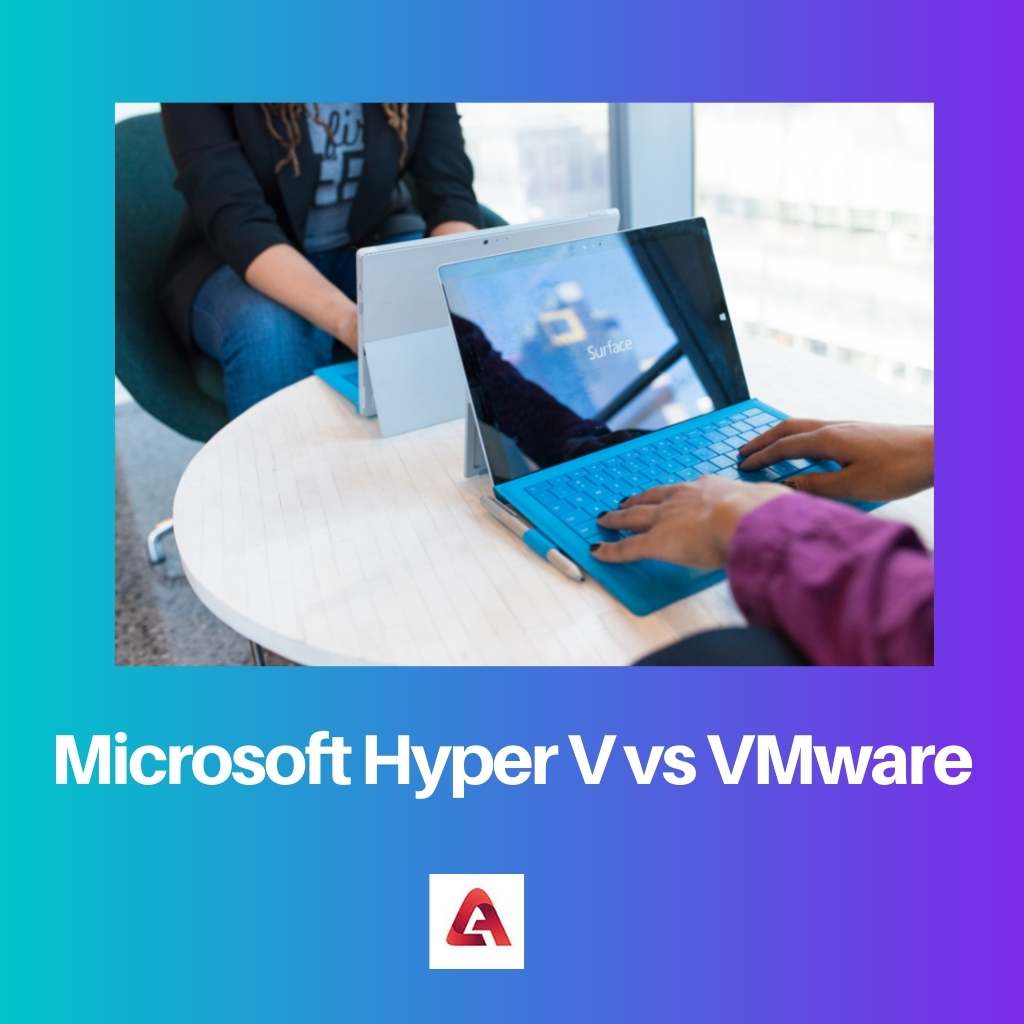Virtualization allows sharing of a single element of computer hardware throughout multiple virtual machines (VMs).
Virtualization simplifies resource and IT administration enhances business sustainability with little downtime, and allows faster hardware and software deployment, in addition to cutting equipment costs and providing significant cost savings.
Hyper-V and VMware are two of the most important hypervisors.
Key Takeaways
- Microsoft Hyper-V is a virtualization platform from Microsoft, while VMware is a suite of products from VMware Inc.
- Hyper-V is limited to Windows environments, but VMware supports multiple operating systems.
- VMware offers a broader range of features and management tools, although Hyper-V is sometimes considered more cost-effective.
Microsoft Hyper V vs VMware
Microsoft Hyper-V is a type-1 hypervisor that is built into the Windows Server operating system. VMware offers multiple virtualization solutions, including VMware ESXi, a type-1 hypervisor that can be run on bare-metal hardware, and VMware Workstation and Fusion, type-2 hypervisors.

Microsoft’s Hyper-V emulator is a type-1 native hypervisor that allows users to create and manage numerous virtualized copies of a desktop, known as virtual machines (VMs).
Hyper-V is a hypervisor platform that allows you to create an IT infrastructure of unlimited intricacy. Each VM runs in its separate region without conflicting with the operations of other VMs in this situation.
VMware vSphere is a hybridization platform for servers developed by VMware. vSphere is a collection of virtualization product portfolios that includes the ESXi virtual machine, vSphere User, VMware Workstation, Cpanel, and others.
Every one of these products works together to form the VMware foundation, which allows for centralized management of the simulated environment established.
Comparison Table
| Parameters of Comparison | Microsoft Hyper V | VMware |
|---|---|---|
| Performance | Storage Spaces Direct technology has been greatly improved by Hyper-V. They’ve added support for ReFS compression and defragmentation. | VMware has heralded numerous improvements in CPU scheduling, along with the eradication of the last global buckle. |
| Storage Deployment | Cluster Shared Drive in Hyper-V is more sophisticated and challenging to utilize than that of the VMware counterpart. | The Virtual Machine File System (VMFS) from VMware has a modest advantage over Hyper-ReFS, V’s, or Robust File System. |
| Scalability | More physical RAM per host and VM may be accommodated by Hyper-V. Furthermore, it can support additional virtual CPUs per VM. | VMware may employ more logical CPUs as well as virtual CPUs for every host. |
| Security | Active Directory is used to handle Hyper-V cybersecurity. Other security mechanisms are significantly more robust in the latter than VMware’s. | VMware encrypts data on the cloud, in transit, and also during workload transfer. |
| Pricing | The price of Hyper-V is determined by the number of threads on the host. Smaller enterprises may find Hyper-V appealing. | VMware charges for each CPU. VMware’s pricing structure appears to be appropriate for larger companies. |
What is Microsoft Hyper V?
Microsoft Hyper-V is an enterprise information centre virtualization platform that debuted with the Windows Operating system in 2008. Hyper-V is a type 1 virtualization that is implemented as a role in the Windows Database server.
Hyper-V may be used as part of a constellation that runs on top of Windows Redundant Cluster services and uses cloud service. With each generation of the Windows Database server, Microsoft continues to enhance the Hyper-V gateway.
Hyper-V is the virtualization of Type 1. Many people assumed that because Hyper-V is implemented as a role within Windows Server.
However, Microsoft continues to perform several pretty clever engineering here within that even after the Hyper-V role is facilitated, Hyper-V is assembled first, and the host operating network operates on top of Hyper-V. Hyper-V provides virtual CPUs and memory and uses a variety of partitions to provide services and I/O peripherals to guest virtual machines while still providing isolation.
However, Hyper-V may be hosted on a single server, for robustness and high availability, Hyper-V is deployed across several servers as part of a Windows Offsite Replication Cluster.
Software applications in Hyper-V clusters are run as a grouping resource, allowing for high reliability. A customized version of Hyper-V virtualization powers the Azure Infrastructure-as-a-Service platform’s foundation.
What is VMware?
VMware is a company that develops and sells cloud computing and virtualized computing applications and services. VMware technologies are divided into two categories: desktop apps and server programs.
Furthermore, VMware desktop applications run on various operating systems like Windows, Linux, and Mac OS. VMware’s technology virtual machines are intended for use on servers.
Furthermore, they are raw metal integrated hypervisors that may impact directly on the server and do not demand a secondary operating system.
VMware’s ESXi is a POSIX-like operating platform that delivers features and capabilities that are quite comparable to other operating systems. It is, however, developed and constructed specifically to operate virtual computers.
This software program adds a runtime environment that allows users to access the physical server hardware.
This enables virtual machine instances to consume centralized server hardware resources while remaining completely oblivious of the other VMs operating on the network.
Whereas Hyper-V, VMware vSphere is a hypervisor platform with a computing system portfolio.
In terms of the vSphere 7 virtualization component, VMware ESXi may authenticate the computational resources of the underlying hardware and spread them among the VMs in the server.
ESXi virtual machines run on the Virtual Machine Operating System, a high-performance cluster root file system.

Main Differences Between Microsoft Hyper V and VMware
- Whenever it comes to grouping, VMware’s Virtual Machine File System (VMFS) has a tiny advantage over Hyper-ReFS, V’s, or Resilient Storage Devices. Cluster Shared Storage in Hyper-V is more sophisticated and difficult to utilize than the VMware counterpart.
- VMware can execute snapshots in manufacturing and trade persistent checkpoints to certain other destinations. Furthermore, Hyper-V supports 64 pictures for every VM, whereas VMware only supports 32.
- VMware employs several methods, including memory optimization, transparent page splitting, and over-provisioning. Hyper-V only has one Amount of memory. This dependence on a primary storage management strategy benefits Hyper-V.
- VMware supports an increasing number of operating processes, including Windows, Linux, etc. Hyper-V compliance is confined to Windows and just a few other operating systems, including Linux.
- VMware costs by the processor, whereas Hyper-V rates by the number of threads on the host.




